UV DTF VS DTF: Differences & Uses Explained
In the ever-evolving world of custom printing, DTF (Direct-to-Film) and UV DTF printing stand out as two groundbreaking methods for transferring high-quality images to various surfaces. Whether you're customizing apparel or personalizing hard goods, choosing between these technologies can significantly impact your production process, results, and product offerings.
This guide explores the core differences, ideal use cases, and essential products from MagicPrint4U to help you make the right investment for your business.
Understanding DTF Printing
DTF (Direct to Film) printing is a heat transfer process where designs are printed onto a film, coated with hot melt adhesive powder, and then heat-pressed onto a fabric. It offers flexibility, color vibrancy, and is excellent for custom apparel.
Core Supplies for DTF Printing
- DTF Pigment Ink: Vivid color output and durability
- DTF Hot Peel Film: Ensures clean transfers
- Hot Melt Powder: Acts as adhesive between film and fabric
- Strong Cleaning Solution & DTF Cleaning Solution: Keeps your equipment in peak condition
Compatible Surfaces
- Cotton, polyester, nylon, and blended textiles
- Canvas bags, hoodies, t-shirts, and caps
Printer Options
Choose between 4-head DTF printers for standard production or 5-head DTF printers for faster output and professional-grade layering.
Advantages of DTF
- Vibrant prints with excellent washability
- Cost-effective for garments and soft goods
- Works on both light and dark fabrics
Limitations of DTF
- Requires a heat press
- Not suitable for hard or curved surfaces
- Daily maintenance is critical for printhead longevity
Understanding UV DTF Printing
UV DTF printing utilizes ultraviolet light to instantly cure UV ink printed on a double-layer adhesive film. It requires no heat press, and the printed decal can be transferred to almost any solid surface using pressure only.
Required Equipment
The star of the show is the UV DTF Printer, which prints using CMYK and white UV-curable inks. It supports varnish for a glossy effect and exceptional detail.
Ideal Applications
- Glass bottles, acrylic ornaments, and tumblers
- Metal, plastic, wood, leather, and ceramic surfaces
- Custom branding and promotional items
Advantages of UV DTF
- No heat press or powder needed
- High-resolution prints with instant curing
- Scratch, water, and UV resistant
- Suitable for uneven, curved, or rigid surfaces
Limitations of UV DTF
- Not compatible with textile printing
- Higher initial investment
- Requires proper ventilation due to UV inks
Comparison Table: DTF vs UV DTF
| Feature | DTF | UV DTF |
|---|---|---|
| Transfer Method | Heat Press | Manual Pressure |
| Materials | Textiles (cotton, blends) | Hard surfaces (glass, acrylic, wood) |
| Finish | Matte/Soft | Glossy/Gloss-varnished |
| Maintenance | Requires regular cleaning | Moderate maintenance |
| Initial Cost | Lower | Higher |
When to Choose DTF
DTF printing is the right choice if your business focuses on apparel, textile merch, and fashion branding. It’s cost-effective, scalable, and versatile for garments.
When to Choose UV DTF
Opt for UV DTF when you need to decorate drinkware, promotional gifts, packaging, and curved or hard items with no heat press. It's perfect for signage and personalized products.
Can You Use Both?
Absolutely. Many print businesses use both DTF and UV DTF to expand their service offerings. DTF covers all garment needs while UV DTF opens the door to non-textile items.
Conclusion
Both DTF and UV DTF technologies empower creators to deliver stunning, durable prints on a wide range of surfaces. The choice depends on your core product offerings, workflow preferences, and budget.
Explore all the tools and materials you need—like DTF Pigment Ink, DTF Film, UV DTF Printer, and more—only at MagicPrint4U.
